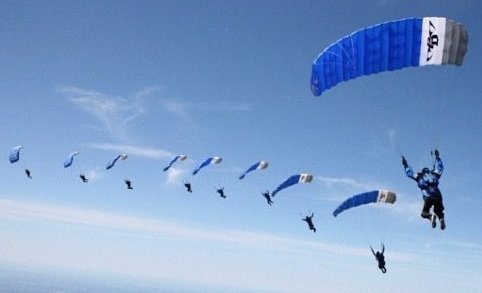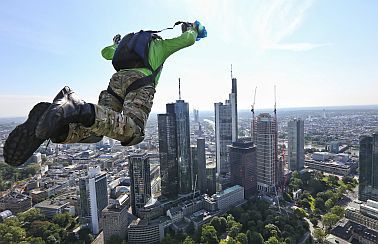Recommended Posts
Quote1. You will need more pressure to flare.
Depending on the canopy and your rear riser "style" it could be less pressure. If you're the type of pilot who has a "pulling down" motion on your rears(more toggle storke like), it requires significantly LESS pressure than if you're a "push out" motion pilot. I prefer the push out motion as it distorts the canopy less because it requires more pressure to level the canopy - basically it makes overcompensation harder (although not impossible
Quote2. There is more risk of a stall; you must not deflect the risers more than about 2 inches.
Yes there is a MUCH greater risk of stall, it happens way sooner than most pilots expect (go out and practice this folks!), however the 2 inches I don't necessarily agree with instead I'd say...How much rear riser input you can give varies greatly from canopy to canopy and wingloading plays an important factor in the stall point as well. For example...my velocities have had incredible rear riser power, however the Blade I jumped recently at a lighter wingloading required MUCH less rear riser input to initiate the onset of a rear riser stall.
Quote3. You'll get the same amount of lift but less drag,
Only to a point, then you'll get much more drag as more of your tail is pulled down. This is where an HP landing differs from a rear riser broken line scenario where you'll be "flaring" the canopy, trying to use the rears as long as possible without stalling and come to a safe stop.
With a HP landing you do NOT want to flare with the rears. It defeats the purpose trying to do as little to the canopy as possible to get it to level out, thus maximizing speed. Most pilots hang on their rears WAAY too long. Also, check out Jim Slatons stuff on rear riser landings.
Quote4. After you get your vertical speed to zero, keep it there and prepare to walk it out/run it out/slide (depending on winds of course.) You won't slow down much during the flare, so loading at 1.2 to 1 in 8 knot winds you'll probably have to run.
Yep, be prepared for it, but you may not need it. An instructor i knew used to rear riser the crap outta his vengence (didn't feel like landing with toggles) and come to a complete stop with very little forward motion. Again I think canopy type and loading have a lot to do with it.
BTW this post wasn't directed @ Billvon, he just happened to have some good points, which I felt could be expanded on.
Key is, as always, practice, practice, practice!
Blue skies and stay safe folks,
Ian
The111 0
I've been practicing up high a lot but am still scared to try for real. But I want to try sometime before I downsize...
EDIT: And another question. Where is the best place to "grab" the risers? Right at the attachment to the lines? And do you drop the toggles or leave them in your hands too?
QuoteInitiation height - do you start a rear riser flare at the same height you'd start a toggle flare?
That's a hard one to answer. I don't have a "set flare" height, but instead adjust my inputs to how the landing is unfolding. With rears it's always better to bail to toggles if you're not 100% sure you are going to pull the landing off. Ideally you'd need just a touch of input to level off the canopy. When you feel you can't lift yourself up using rears is the time to transfer to toggles (assuming a good approach).
QuoteWhere is the best place to "grab" the risers? Right at the attachment to the lines? And do you drop the toggles or leave them in your hands too?
I grab them high (at the attachments) and NEVER, EVER let go of those toggles. Bury them deep over your hands. Drop toggles kill/maime.
Blues,
Ian
The111 0
I'm not asking about HP landings, however, I think my confusion does still apply. I understand why you'd recommend against dropping toggles, but if I learn rear riser landings now, it will be from a straight in approach (NOT a HP landing), and it will be for the sole purpose of preparing me for a broken brake line (in which case the toggles will be useless). To me, even under my huge 170 with no HP speed inputs, landings still seem to happen relatively quickly and instinctually. I start flaring and next thing I know I'm planing out and surfing (if the wind is low enough). It seems like a split second. If I *were* to try rears, I can't see having the time to think about aborting them halfway through and going back to toggles. I feel like by then my ankles would already be hurting. Maybe this means I shouldn't try a RR landing yet. I just feel like if I did I'd want to commit and NOT think about reverting to toggles during the flare...
billvon 2,380
> second between letting go of the rear pressure and adding pressure to
> the brake lines, you'd lose lift and drop.
Start your flare by spreading your rear risers. When you drop the risers, let your hands "spring" away from the risers; this takes up slack in the brake lines and begins the flare. Practice this up high first (of course) and make your first real attempt on a decent wind day over soft ground.
QuoteI just feel like if I did I'd want to commit and NOT think about reverting to toggles during the flare...
I understand your concern, but the drop doesn't happen as fast as you'd think. A WAY, WAY worse scenario is stalling out on rears when you're in the corner (I know you're not talking about HP landings here but the emphasis is on rear riser stall) and having your canopy fold up behind you.
You've been practicing rear riser landings up high, so practice the transfers - even if you don't intend to use it you may need to one day.
Blues,
Ian
The111 0
There’s probably a reason they don’t teach landing on rear risers in the CPC for a reason...
Hajo 0
ianmdrennan
..................
You've been practicing rear riser landings up high, so practice the transfers - even if you don't intend to use it you may need to one day.
Blues,
Ian
Respect.
True, helpful and loaded with knowledge by own experience.
Your posts are among of the best in this forum.
(and I fly Icarus canopies) ;-)
Maybe a small intention from me:
the threadstarter should go and have a good (!) canopy coach before starting to do own try and error landings ...
Learning that you have more than 2 toggles and 2 risers for flying (and landing) your canopy is important and may save your life.
With sufficient thrust,
pigs just fly well
Westerly 61
So I guess the question is can you safely try to level out on your rears a few feet off the ground, release the rears and then flare with the toggles?
pchapman 261
Hajo
the threadstarter should go and have a good (!) canopy coach before starting to do own try and error landings ...
Well the original poster might well now a competitive canopy pilot, or have left the sport years ago, since this is a thread resurrected from 2004.
It makes sense to practice the 'feel' of the rear riser or rear riser plus toggles flare up high, just as they do in canopy courses for newbies doing regular flares. So one should know from experiments up high, roughly how long one has before the flare feels mushy or one seems to be sinking again, and how much flare one still has in the toggles afterwards (when starting by practicing only part of the flare on risers). Seat of the pants g-loading is one's cue to how much flare one has, when up high with no ground nearby as a visual reference.
Still, the problem remains, it is difficult to feel exactly what is going on when practicing flares up high, so at some point one just has to try starting one's actual landing flare with rears. One wouldn't try the full flare, just start a little bit on rears to get a feel for the reaction before finishing with toggles.
I sometimes wonder if it is a bit difficult to do a decent rear riser landing if one is on a moderately lightly loaded canopy. I've done it on a very low wing loading canopy (eg, Para Foil at .65 loading), and on canopies at 1.25 loading and above. But there may be a range in between where the canopy isn't super slow, but doesn't have enough energy for much of a swoop at all. Which leaves one needing a decent flare to avoid a hard landing, but not having much flare time & energy to plane out and adjust the landing trajectory. (Similarly, if I were doing a downwinder on a canopy, I want a canopy with some speed so that I have more flare time & energy to adjust the landing perfectly, to lightly transfer weight for a sliding landing.)
I don't personally know for sure, but that concern might make it a bit trickier for someone to learn rear riser landings when at say 1.1 loading on their first owned canopy. As suggested earlier in the thread though, practicing on a day with a decent bit of wind (but not too high a wind which gets turbulent), will make the landings slower and easier. Just like one might do when downsizing.
Learning rear riser landings is still a bit tricky as one doesn't get good feedback when practicing up high and one has limited time during any actual landing flare to get everything just right. It's a bit like many of the other canopy landing exercises on 'downsizing lists' (like flare turns, crosswind landings, etc) -- they all add a little risk so one should have 'regular' landings down pat before adding new things to the landing. Indeed rear riser landings are part of one of the popular downsizing checklists.
pchapman 261
WesterlyI've always been concerned if I try to land on my rears and then flare with the toggles the last minute, letting up from the rears will cause the canopy to dive.
Yeah one has to be fast in the transition. Maybe going from 'hands pulling down rears a few inches' to 'hands another foot lower' in a split second, so that one doesn't let the canopy dive in between.
So it does mean being comfortable with one's normal flare, and having a good feeling how much the toggles need to be pulled down at any part of the flare. One does have to be quick and decisive about it.
QuoteSo I guess the question is can you safely try to level out on your rears a few feet off the ground, release the rears and then flare with the toggles
Whether that in particular works, willl depend on the energy available. I'd practice starting with the rears, but not attempt to fully level out. One might find after levelled out at 3 ft high, that one doesn't have enough energy left with the toggles to give time to begin to drop down again, and then flare out level at zero feet.
So I'd rather (if new at this) start pulling out on rears, but transition to toggles fairly early, without being fully level. Keep more energy for the toggle flare after. (While one doesn't want to end up flared too high and slow on rears, of course one doesn't want to fail to pull out level before hitting the ground, so there's a balance to be found...)
As one practices, one will see how much one can do on rears while still having enough energy left with the toggles.
richoH 6
WesterlyI've always been concerned if I try to land on my rears and then flare with the toggles the last minute, letting up from the rears will cause the canopy to dive. Sort of like if you went into a half-flare, then completely let up and went into a full flare.
So I guess the question is can you safely try to level out on your rears a few feet off the ground, release the rears and then flare with the toggles?
Don't learn to fly parachutes from the internet.


.thumb.jpg.4bb795e2eaf21b8b300039a5e1ec7f92.jpg)





1. You will need more pressure to flare.
2. There is more risk of a stall; you must not deflect the risers more than about 2 inches.
3. You'll get the same amount of lift but less drag, so you will notice that the flare feels completely different. You'll level out but your forward speed won't drop much. Do NOT continue to flare to get your horizontal speed lower; you'll stall. All you want to do is get your vertical speed to zero.
4. After you get your vertical speed to zero, keep it there and prepare to walk it out/run it out/slide (depending on winds of course.) You won't slow down much during the flare, so loading at 1.2 to 1 in 8 knot winds you'll probably have to run.
Share this post
Link to post
Share on other sites